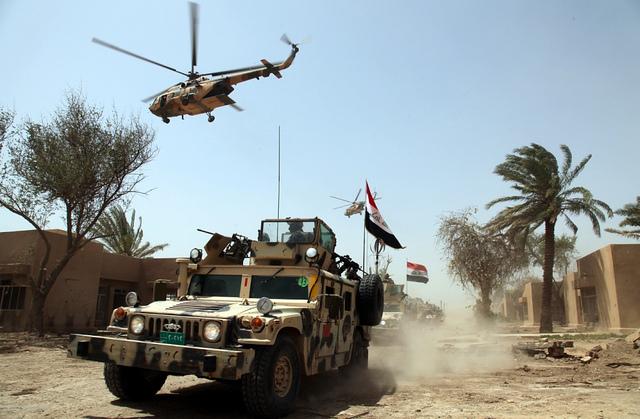 Below is an extract from ASPI’s forthcoming publication Strike from the air: the first 100 days of the campaign against ISIL. Click here to register for the publication’s free launch event.
Below is an extract from ASPI’s forthcoming publication Strike from the air: the first 100 days of the campaign against ISIL. Click here to register for the publication’s free launch event.
The US has had combat advisers in Iraq since August 2014; Australian special operations forces joined Operation Inherent Resolve on the ground in mid-November. The initial 200-strong Australian element joined a force of advisers from various countries that form part of the official coalition. They find themselves dealing with the reality of other influences on the ground, the most notable being the Iranian Revolutionary Guard Corps Quds force.
While much of the media focus has been on airstrikes and air power, the land component advisory force has been busy setting the conditions for the current and future efforts of the Iraqi security forces to push ISIL out of Iraq and reassert control over Iraqi territory and its population. These ‘advise and assist’ efforts have been constrained by restrictions on activity and complicated by the armed politics of a fragile and broken Iraq. We’re already seeing how some of these trends and tactical pressures are forcing operational and strategic decisions, including the recent addition of 1,500 more US troops and President Obama’s direct request of Prime Minister Abbott for more Australian advisers.
According to official ADF sources, the Australian advisers are working with the Iraqi Counter Terrorism Service. The service is an independent agency of the Iraqi Government that works directly for the prime minister. The Iraqi Special Operations Force (ISOF) is the primary operational arm of the service.
ISOF is probably Iraq’s most trusted and capable military unit. However, when Iraqi Army units disintegrated en masse earlier this year, the ISOF brigades held together and were forced to do much of the fighting. As a result, they’ve suffered a very high attrition rate and by some accounts are at 50% of their former strength. The Australian advisers therefore face a severely weakened unit with a core cadre of capable and experienced fighters and a lot of inexperienced replacements. Much like business consultants hired by a once-profitable corporation, Australian special operations forces have to establish trust and rapport with these experienced soldiers and officers. They’ll need to focus on assisting the unit with its systems and processes. This’ll probably include advice and assistance on operations, but, more importantly, it’ll likely include efforts to sustain the organisation in the long run. Logistics, maintenance, personnel systems and the training of replacements are likely to demand the time and effort of the Australian advisers in the near term.
As their higher-end assets were destroyed, ISIL commanders recognised that convoys of multiple vehicles and high-signature armoured vehicles provided easy targets for coalition air power. They’ve clearly dispersed their forces and concealed any remaining armoured assets. ISIL still holds key terrain and will likely defend much of it, or return to guerrilla action and insurgent attacks after Iraqi security forces have seized territory. This change in tactics will make airstrikes less effective over time and increase the demand from Iraqi security force leaders and their advisers for close air support directed by tactical air controllers embedded with ground units.
Such a shift will require a revision of current constraints, which only allow advisers to be physically present at battalion headquarters and above. To continue to take advantage of coalition air power in the subsequent phases of Operation Inherent Resolve, this minor change in tactics is appropriate and likely. There’ll be some domestic challenges to explain the intentional proximity of advisers to combat. The promises of ‘no boots on the ground’ and coalition soldiers not being involved in combat will have to be modified.
In addition to providing more effective air support, allowing advisers to accompany their Iraqi counterparts will help to moderate the influence of Iranian Quds force operatives and their increasingly powerful Shia militias. Quds force advisers have been accompanying their militia counterparts and lending direct combat advice and support during offensive operations for several months, even before coalition airstrikes began.
Western coalition advisers working with ISOF and Iraqi Army units will be able to boost the influence of official state organisations and counter the armed political influence of militias only if they’ve the operational and tactical flexibility to accompany their counterparts and ensure their success on the battlefield. If the Iranian-advised militias are permitted to seize more territory, they’ll probably extract a painful price from Sunni minority communities (several already have) and will have even more political capital in post-ISIL Iraq. To ensure that Iraqi state institutions recover their credibility, the Iraqi Army needs to achieve tactical success and demonstrate that it can secure Sunni areas and incorporate Sunni tribal militias in a manner that’ll encourage more Sunnis to reject ISIL and work with the government.
Lieutenant Colonel Jan K. Gleiman is an active duty US Army officer and a visiting fellow at ASPI from United States Pacific Command. He is a co-author of Strike from the air: the first 100 days of the campaign against ISIL. These are his personal views. Image courtesy of Flickr user United States Forces Iraq.